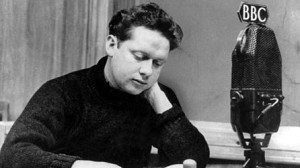Posted: May 3rd, 2014 | No Comments »
‘Rage, rage against the dying of the light.’ It’s the centenary of Dylan Thomas’s birth, a favourite poet of mine ever since I was given a copy of Under Milk Wood as a young lad. I didn’t think I’d be able to work Thomas into this blog but it turns out that, as a boy, as a boy, in Swansea he did dream of China….
Dylan Thomas from Quite Early One Morning:Â
         “I was born in a large Welsh town at the beginning of the Great War—an ugly, lovely town (or so it was and is to me), crawling, sprawling by a long and splendid curving shore where truant boys and sandfield boys and old men from nowhere, beachcombed, idled and paddled, watched the dock-bound ships or the ships streaming away into wonder and India, magic and China, countries bright with oranges and loud with lions; threw stones into the sea for the barking outcast dogs; made castles and forts and harbours and race tracks in the sand; and on Saturday afternoons listened to the brass band, watched the Punch and Judy, or hung about on the fringes of the crowd to hear the fierce religious speakers who shouted at the sea, as though it were wicked and wrong to roll in and out like that, white-horsed and full of fishes.”
Posted: May 3rd, 2014 | 1 Comment »
  RAS WEEKENDER
SPENCER DODINGTON will lead a walking tour of
Architect Paul Veysseyre’s Historic Art Deco Buildings.
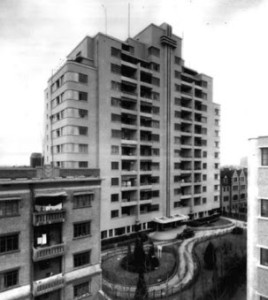
Â
1:30pm (2pm start) – 4pm
venue TBA
PRIORITY TO RAS MEMBERS
Paul Veysseyre was a leading French architect who lived in Shanghai from 1921 to 1937, one of the principles of the architectural firm Leonard, Veysseyre & Kruze. Over a hundred of his buildings are still standing in Shanghai, contributing to the city’s extremely diverse architectural heritage. Well-known works include the Cercle Sportif Français (now the Okura Garden Hotel), the Boissezon Apartments and the Dauphine Apartments, just to name a few.
Â
In this 2-hour guided walk, Spencer Dodington will lead RAS members and friends around parts of the Former French Concession to view some of Veysseyre’s work. Spencer is the author of Paul Veysseyre: Shanghai’s Art Deco Master, which chronicles the architect’s life and works.
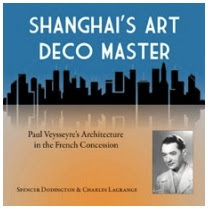
Â
Spencer Dodington is an expert on the history and restoration of Shanghai Art Deco architecture. His work in the city has been chronicled in magazines and newspapers around the globe. He lives and works in Shanghai.
Â
Â
It took Spencer Dodington and Charles Lagrange three years of researching and writing, using original and new photos, to finally give readers a close-hand account of Veysseyre’s life. The book is not only the first comprehensive book about him, it is also the only recent book in English offering a succinct history of the French Concession and its legacy. Part of this legacy is the city’s Art Deco image, due to Veysseyre.
Â
In her foreword for the book, Tess Johnston writes: “Spencer Dodington and Charles Lagrange are the perfect choice to document Veysseyre’s life and work… Anyone who loves architecture in all its variety – and wants to understand how it evolved – will find this volume illuminating.”
RSVP: to RAS Bookings at: bookings@royalasiaticsociety.org.cn
Â
ENTRANCE: Members 100 RMB – Non Members 150 RMB
Â
Copies of the book, Shanghai’s Art Deco Master, Â will be available for sale (cash purchase only – 350 RMB) at the end of the Walk.
Â
Priority for RAS members. maximum of 20 participants. Those unable to make the donation but wishing to attend may contact us for exemption.
Posted: May 1st, 2014 | 3 Comments »
Back in July 2011 I blogged about the writer WG Sebald, who in his masterpiece of travel writing The Rings of Saturn tells of a train, once belonging to the Guangxu emperor, that had been brought home and ran on a small line in Suffolk – the full story from Sebald here and some film of the old train concerned here. Well, apparently it’s a bogus tale. A regular China Rhymer contacted me to inform that Ransome and Rapiers, the manufacturers of the train, never exported any trains to China and that they never made any trains that would fit Chinese rail gauges – so that’s that lovely tale blown out of the water. Ho hum….
But here anyway is an undated picture of the Chinese Imperial train all decked out and running on the small line that followed the Tartar Wall around Peking (which I’ve blogged about here, way back in 2008)
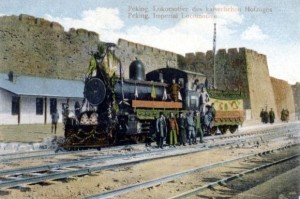
Posted: April 30th, 2014 | No Comments »
From Canada to the Orient….
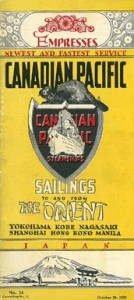
Posted: April 29th, 2014 | No Comments »
A new history of the China-India opium trade from Hunt Janin….
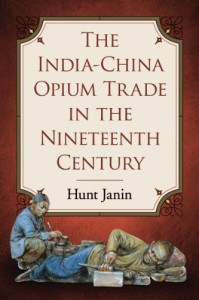 From 1823 to 1860 a fleet of small, fast brigs and schooners carried chests of opium from India to China, often facing the challenges of pirates and typhoons along the way. This shadowy trade, conducted by American, British, and Indian firms, thrived despite its moral and legal consequences.
From 1823 to 1860 a fleet of small, fast brigs and schooners carried chests of opium from India to China, often facing the challenges of pirates and typhoons along the way. This shadowy trade, conducted by American, British, and Indian firms, thrived despite its moral and legal consequences.
Drawing largely on primary sources, the story of the opium trade comes through in the voices of those who saw it firsthand. Appendices describe a favourite shipboard recipe, two of the ships involved in the trade and their crews, excerpts from accounts of the Opium War, and language equivalents for proper and place names. A bibliography is included, and maps and photographs help illumine this important and unusual period of history.
Posted: April 27th, 2014 | No Comments »
Asia House Bagri Foundation Literature Festival 2014
6th – 21st May 2014
FINAL PROGRAMME ANNOUNCED

Prize winning novelists Hanif Kureishi, Kamila Shamsie, Tash Aw and Romesh Gunesekera, award-winning BBC journalist John Sweeney, plus debates on North Korea, Tiananmen 25 years on and changing sexual mores across Asia, line-up alongside an evening of British Asian humour, Vietnamese cookery at lunchtime and interactive events for families
Now in its eighth year and with a new title sponsor, the Asia House Bagri Foundation Literature Festival is the only UK festival dedicated to pan-Asian writing and will take place at Asia House in May. A stimulating mix of literary talks, performance, topical debate, humour, cookery, tai chi and interactive family events from renowned authors, performers and thinkers- home-grown and from across Asia – come together in this truly unique festival.
With a range of events covering more than 17 countries, the Festival this year includes authors writing about China, Japan, Malaysia, North Korea, South Korea, Pakistan, India, as well as Thailand, Burma, Vietnam, Nepal, the Middle East, Kazakhstan, Azerbaijan, Palestine, Sri Lanka and Britain.  This year’s theme is Changing Values across Asia.  Warming up with three exciting pre-festival events in April, Asia House will feature a session on China’s changing values with Booker Prize long-listed author Tash Aw and Yiyun Li, author of Kinder than Solitude; Man Asia Prize winner Kyung-sook Shin, who joins fellow South Korean novelist Krys Lee and British Pakistani Qaisra Shahraz to debate the effect of political separations on their countries and their writing, at an event in partnership with the British Council/London Book Fair Korea Market Focus and Why do Indians Vote?, a wide-ranging discussion on the world’s largest democracy and its upcoming election.
Continuing the ‘Changing Values’ theme into the main festival in May, acclaimed journalists and China experts Jonathan Mirsky, Michael Bristow and Jonathan Fenby explore China 25 years after Tiananmen; foreign correspondent Peter Popham, examines Burma two years after its milestone election, while Shereen el Feki  [Sex and the Citadel] and Sally Howard [The Kama Sutra Diaries] take a serious but entertaining look at changing sexual mores in the Middle East, India and Pakistan.
Literary superstar Hanif Kureishi launches the Festival on 6 May as he discusses his new novel, The Last Word, while award-winning Pakistani author Kamila Shamsie introduces her hotly anticipated novel of friendship, injustice and love, A God in Every Stone. The best of Asian literature is further celebrated as new works by acclaimed Sri Lankan novelist Romesh Gunesekera, one of Granta’s Best of Young British novelists Xiaolu Guo and Pakistani-born Roopa Farooki are previewed in a special showcase event ahead of publication. A new series, Extra Words will introduce debut authors from Pakistan, Nepal and Thailand.
Award-winning BBC reporter John Sweeney [North Korea Undercover] joins author of North Korea: State of Paranoia, Paul French to analyse the threat posed by that country, while historian John Keay introduces the first comprehensive history of South Asia as a whole with his new book Midnight’s Descendants. Digital freedom in East Asia will be analysed with Thai blogger Giles Ji Ungpakorn and Anja Kovacs from the Internet Democracy Project in Delhi and others, in an event in partnership with English PEN.
But not all events will focus on ‘Changing Asian Values’, some will be just for fun – look out for lunchtime cookery with The Vietnamese Market Cookbook authors and Tai chi, Origami, Ninja Meerkats and poetry workshops for children. Joining forces with Penned in the Margins at Rich Mix in East London, the festival programme includes The Shroud, a two-man, miniature epic about loss, time and the things that connect us, with Siddhartha Bose and Avaes Mohammed. British Asian humour will be hotly debated by a panel including journalist Sathnam Sanghera, BBC head of comedy Saurabh Kakkar, comedian Shazia Mirza and writer producer of hit TV shows Goodness Gracious Me, The Kumars at Number 42, The Office and Citizen Khan, Anil Gupta; and the author of Packing Up: Further Adventures of a Trailing Spouse, Brigid Keenan takes us on a wildly funny tour through her life in Kazakstan, Azerbaijan and Palestine.
In addition to events at Asia House, the Asia House Bagri Foundation Literature Festival I this year extends its youth engagement programmes with two-day writing workshops and author visits in 6 London area schools and 6 others across Newham, Manchester, Leicester and Birmingham aiming to reach 300+ students. Â There is a student writing competition with the top five students winning a day of mentoring with writing, publishing and communications professionals.

Posted: April 26th, 2014 | No Comments »
A fascinating piece in this weekend’s Financial Times by David Pilling on CT Loo (below), the Paris-based Chinese antiquities dealer who arrived in France in 1902 and established a reputation as the major dealer in Chinese art and atrefacts in Europe. Very little has ever really been known about Loo for sure – his life has always been a mix of mystery, obfuscation and rumour. I stumbled across his famous pagoda like showroom in Paris many years ago and did eventually visit it properly some time back when in Paris searching for Chinoiserie remnants in the nearby Parc Monseau (see blog post here). Oddly enough CT Loo popped up again recently when I was asked to talk about Peking in 1930 at the Noguchi Museum in New York as part of the events they had organised around their exhibition on Noguchi’s time in Peking studying under Qi Baishi that year.
Here’s my small Loo anecdote then – while in Peking in 1930 the Japanese-American sculptor Noguchi had a small circle of western friends. Among these was the Frenchman Jean-Pierre Dubosc.
Dubosc was attached as a diplomat to the French Legation in Peking and an avid collector of Chinese artefacts. He also happened to be married to Janine Loo, one of CT Loo’s daughters. Dubosc was a habitué of the antique and curio shops of Peking from where he sourced various treasures for European and American museums (most notably the Guimet Museum in Paris, a specialist collection of Asian art) as well as for C.T. Loo’s dealership business.
Anyway, if you read one thing this weekend then this article is the one and it also promises a forthcoming biography of Loo, which I, for one, eagerly await.
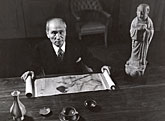
Posted: April 26th, 2014 | No Comments »
Macao’s full and secret history during World War Two still remains to be told and political correctness and erstwhile later “patriots” of Beijing’s massive family and business interests still prevent that. However, John Reeves’s memoirs of his time as British Consul in Macao between 1941-1946 goes some way to filling that gap….
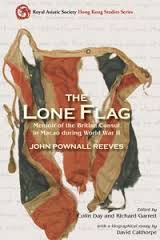
When Hong Kong fell to the Japanese on Christmas Day 1941 Macao was left as a tiny isolated enclave on the China Coast surrounded by Japanese-held territory. As a Portuguese colony, Macao was neutral, and John Reeves, the British Consul, could remain there and continue his work despite being surrounded in all directions by his country’s enemy. His main task was to provide relief to the 9,000 or more people who crossed the Pearl River from Hong Kong to take refuge in Macao and who had a claim for support from the British Consul.
The core of this book is John Reeves’ memoir of those extraordinary years and of his tireless efforts to provide food, shelter and medical care for the refugees. He coped with these challenges as Macao’s own people faced starvation. Despite Macao’s neutrality, it was thoroughly infiltrated by Japanese agents and, marked for assassination, Reeves had to have armed guards as he went about his business. He also had to navigate the complexities of multiple intelligence agencies—British, Portuguese, Japanese, Chinese Nationalist—in a place that was described as the Casablanca of the Far East.
John Pownall Reeves (1909–78) was British Consul in Macao 1941–46.
